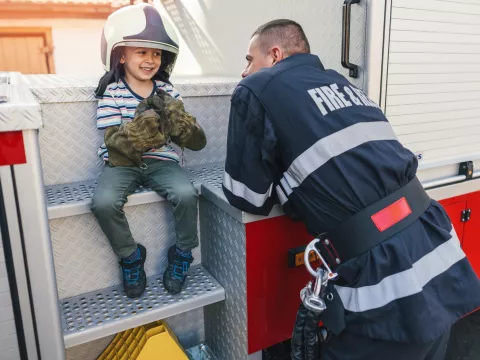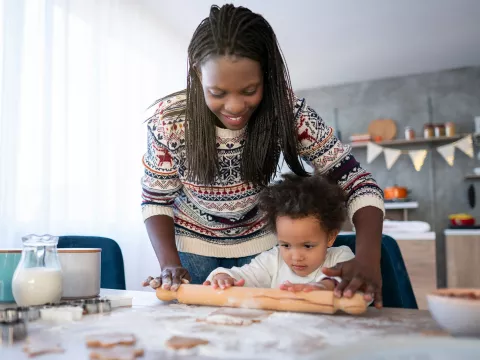- AdventHealth

Firefighters Are Friends: Teaching Kids Fire Safety Basics
Fire is fascinating, and scary, to kids of all ages. Kids may be curious about fire or want to emulate their parents’ behaviors with matches or lighters. But as adults and firefighters know, a single match can start a devastating home fire.
For parents, it’s essential to teach children fire safety basics at an early age to prevent tragedies and stay safe. Meeting firefighters and learning about their role in society, installing fire alarms, playing educational games and practicing a fire escape plan are all ways to help kids understand fire safety basics.
Educating Kids on Fire Safety
Every year, children playing with fire leads to approximately 300 deaths and $280 million in destroyed property, according to the U.S. Fire Administration. Most fires that are started by children are set by preschoolers and kindergarteners, so early education on fire safety is key.
Learning about the dangers of fire is necessary for kids, but it doesn’t have to be scary or overwhelming to be memorable. You can teach kids fire safety basics in several fun ways that they’ll remember.
Read Books on Firefighters and Fire Safety With Kids
Reading is a great way for kids to learn about firefighters and fire safety in a fun way. There are plenty of books available for all reading levels that kids can enjoy, including:
- “A Day With Firefighters” by Jan Kottke
- “Fire! Fire!” By Gail Gibbons
- “Firefighters A to Z” by Chris L. Demarest
- “Firefighter Frank” by Monica Wellington
- “Hello, Fire Truck!” by Marjorie Blain Parker
In addition to reading books, another great way to help kids remember fire safety basics is to make it a game they can play. You can order an educational fire safety kit for kidswith games, videos and other resources that teach kids how to play safely and escape a fire.
Have Kids Meet Firefighters
One of the best ways to show kids that firefighters aren’t scary is to introduce them to one. Many public schools have firefighter classroom visits where firefighters talk to the kids about their jobs and teach fire safety basics like stop, drop and roll.
However, you can also call or visit your local fire station to arrange a tour with your kids. At the fire station, they can meet firefighting men and women, ask them questions and possibly even sit in a firetruck.
Whether kids meet firefighters in the classroom or on a fire station tour, this hands-on experience teaches kids that firefighters:
- Are available 24 hours a day to help in an emergency
- Are friends, not strangers to be afraid of
- Are important community members who deserve our gratitude
- Drive firetrucks with loud sirens to get to a fire, fast
- Have special equipment and gear that help them do their job
- Have special training to be safe in a fire
- Help people get out of burning buildings safely
- Put out fires inside and outside
- Save people, pets and homes
- Transport injured people to hospital emergency departments
Outfitting for Safety: Learning About Firefighter Gear
When kids meet firefighters, they’ll learn about all the special gear that firefighters wear, along with the tools they use every day, including:
- Firetrucks, which have loud sirens and bright lights (these mean help is on the way!)
- Firetruck hoses, which help put out fires
- Firetruck ladders, which help firefighters reach tall buildings
- Protective firefighter gear, like fireproof boots, pants and coats, masks, helmets and flashlights
Firefighters dressed in their heavy gear, with coats, masks and oxygen tanks, can be frightening to young children. Compared to older kids, children ages 4 and under have the highest risk of dying in a fire, and that’s partly because they hide — from both the fire and firefighters. Many firefighters report having to search for kids in a house fire because they will commonly hide under furniture or in closets.
However, as kids learn about and see firefighter gear firsthand in a safe environment, like at school, they’ll learn that firefighters aren’t people to fear.
Teaching Fire Safety at Home for Kids
At the fire station, kids can learn how firefighters respond to house fires quickly and effectively. At home, you can continue their fire safety education by teaching them how fires could start at home, what to stay away from and how to escape a fire in the house.
Prevent Home Fires Started by Kids
To prevent a fire in your home, kids must first understand that fire is dangerous, and that things that make fire, like matches and lighters, are not toys. They’re only for adults to use, and if they see siblings or other kids using matches or lighters, they should tell a trusted adult right away.
Make sure any lighters you use have child-resistant features, and that they’re stored in a cabinet out of kids’ reach or in a locked drawer.
In addition to lighters and matches, explain that the stove, oven, fireplace, space heaters and candles (flameless ones are safest) also create heat and could start a fire. A good rule of thumb is to put three feet between heating items and anything that could catch on fire.
There are plenty of opportunities to teach kids about fire safety outdoors, too. Grilling, having a campfire or bonfire or setting off fireworks are all perfect opportunities to expand kids’ knowledge about fire safety, how to stay safe outside and prevent fires from spreading.
Teach Kids About Smoke Detectors
One of the most important parts of fire safety education for kids is teaching them about smoke alarms. Let kids hold a detector and look at the buttons, and explain what the alarms are, how they work, what sound they make and why they’re important.
Get kids involved by having them help you test every smoke alarm in your home once a month. There should be multiple detectors on each floor, outside of bedrooms and sleeping areas, specifically. You can have the kids see if they can hear the alarm from their bedroom, or from downstairs, to show why it’s important to have multiple in the house.
If your smoke alarms are chirping, it’s time to change the batteries. Typically, you’ll change the batteries when you change your clocks to fall back or spring forward, and they’ll need to be replaced every 10 years.
Teach Kids How to Escape a Home Fire
If a home fire happens, your family may have as little as two minutes to get out of the house safely.
Developing a fire escape plan with your family is the most important part of fire safety education. To ensure every family member understands the plan fully, plan a practice drill at least twice a year.
Explain to kids that when they hear the fire alarm (possibly at night), they should follow these steps to get out of the building safely.
Identify Two Exits From Every Room
Typically, you will find a door and a window in each room of your home. These are the best exit points if a fire occurs. Show kids how to press the back of their hand against their bedroom door handle to test whether it’s hot. If it is, they should use the second exit from the room, which may be a window. Make sure windows can be easily opened and crawled through, and that kids know it’s only appropriate to do so in an emergency.
Know How to Fall and Crawl, and Stop, Drop and Roll
If there’s a fire, the air will be clearer closer to the floor, so kids should practice the fall-and-crawl maneuver to stay low and exit the room safely. Make sure kids know that if their clothes catch on fire, they should stop moving, drop to the floor and roll to extinguish the flames.
Know the Phrase “Don’t Hide, Go Outside”
Small children may run and hide if they hear a fire alarm, so it’s essential to teach them that this behavior isn’t safe. Make sure the phrase “don’t hide, go outside,” is part of your kids’ fire safety education.
Designate a Meeting Point Outside
As part of your fire escape plan, choose a meeting area outside, like a tree or a landmark, where everyone should meet after safely exiting the house.
Know to Get — and Stay — Out
Be sure to remind kids that getting out of the house as quickly as possible is the most important thing in a fire emergency. Kids should never go back inside the house after getting out. Once outside at the designated meeting spot, they should call for help. Dial 911 if someone hasn’t already and wait for the firefighters to arrive. Only firefighters should go back inside to help anyone who is still inside.
Obey Your Firefighter Friends
Make sure kids know that their local firefighter friends will come help if there’s a fire, and that once they arrive, they’ll do everything they can to keep everyone safe. Teach kids that if a firefighter calls to them or gives an instruction, they should listen and heed their firefighter friends.
Expert Care When the Unexpected Happens
In the case of a fire, be sure your kids know to follow your family’s fire escape plan and to call 911 right away so firefighters can get there quickly.
Your local firefighter team can make sure each member of your family is safely outside and can help you get immediate care at your neighborhood AdventHealth emergency department, like the pediatric emergency unit at AdventHealth for Children.
At AdventHealth for Children, our facilities are designed with kids’ needs in mind, helping them feel calm and lifting their spirits, too. Our board-certified, emergency physicians are specifically trained to help soothe little ones, and are nationally recognized for the care they give to kids of all ages.
You can count on us for expert care to heal any wounds, at any time of day. Find your closest ER or learn more about emergency care at AdventHealth today.



